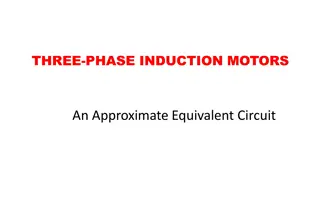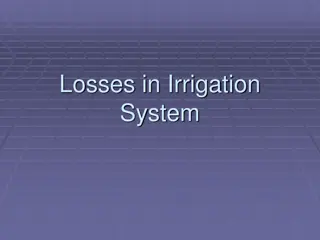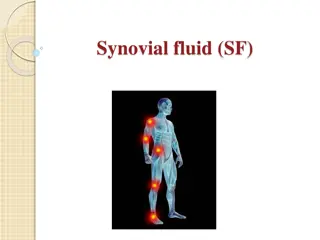Understanding Energy Losses in Fluid Power Systems
Liquids such as water and petrol flow more easily than oil due to viscosity differences. Energy losses occur in valves and fittings, and the selection of fittings is crucial to minimize losses. The chapter delves into in-depth circuit analysis, laminar and turbulent flows, and the concept of Reynolds number in fluid dynamics.
Download Presentation

Please find below an Image/Link to download the presentation.
The content on the website is provided AS IS for your information and personal use only. It may not be sold, licensed, or shared on other websites without obtaining consent from the author. Download presentation by click this link. If you encounter any issues during the download, it is possible that the publisher has removed the file from their server.
E N D
Presentation Transcript
1 6.1 Introduction Liquids such as water or petrol flow much easily than other liquids such as oil. The resistance to flow is essentially a measure of the viscosity of a fluid. The greater the viscosity of a fluid, the less readily it flows and the more is the energy required to move it. This energy is lost because it is dissipated as heat. Energy losses occur in valves and fittings. Various types of fittings, such as bends, couplings, tees, elbows, filters, strainers, etc., are used in hydraulic systems. The nature of path through the valves and fittings determines the amount of energy losses. The more circuitous is the path, the greater are the losses. In many fluid power applications, energy losses due to flow in valves and fittings exceed those due to flow in pipes. Therefore, a proper selection of fitting is essential. In general, the smaller the size of pipe and fittings, the greater the losses. The resistance to flow of pipes, valves and fittings can be determined using empirical formulas that have been developed by experimentation. The energy equation and the continuity equation can be used to perform a complete analysis of a fluid power system. This includes calculating the pressure drops, flow rates and power losses for all components of the fluid po wer system. The purpose of this chapter is to study the detailed circuit analysis of energy losses in fluid power systems containing valves, fittings and other power transmission and energy conversion elements. 6.2 Laminar and Turbulent Flows When speaking of fluid flow, one refers to the flow of an ideal fluid. Such a fluid is presumed to have no viscosity. This is an idealized situation that does not exist. When referring to the flow of a real fluid, the effects of viscosity are introduced into the problem. This results in the development of shear stresses between neighbouring fluid particles when they move at different velocities. In the case of an ideal fluid flowing in a straight conduit, all the particles move in parallel lines with equal velocity. In the flow of a real fluid, the velocity adjacent to the wall is zero; it increases rapidly within a short distance from the wall and produces a velocity profile such as shown in Figure 6.1. (a) (b) Figure 6.1 Typical velocity profile: (a) Ideal fluid. (b) Real fluid
2 There are two types of flow in pipes: 1. Laminar flow: This is also known as streamline or viscous flow and is illustrated in Fig.6.2. In streamline flow, the fluid appears to move by sliding of laminations of infinitesimal thickness relative to adjacent layers; that is, the particles move in definite and observable paths or streamlines. The flow characteristic of a viscous fluid is one in which viscosity plays a significant part. Figure 6.2 Laminar flow 2.Turbulent flow: It is illustrated in Fig.6.3. It is characterized by a fluid flowing in random way. The movement of particles fluctuates up and down in a direction perpendicular as well as parallel to the mean flow direction. This mixing action generates turbulence due to the colliding fluid particles. This causes a considerable more resistance to flow and thus greater energy losses than those produced by laminar flow. A distinguishing characteristic of turbulence is its irregularity, there being no definite frequency, as in wave motion, and no observable pattern, as in the case of large eddies. Figure 6.3 Turbulent flow 6.3 Reynolds Number In the flow of a fluid through a completely filled conduit, gravity does not affect the flow pattern. It is also obvious that capillarity is of no practical importance, and hence significant forces are inertial force and fluid friction due to viscosity. The same is true for an airplane traveling at speed below that at which compressibility of air is appreciable. Also, for a
3 submarine submerged far enough so as not to produce waves on the surfaces, the only forces involved are those of friction and inertia. Considering the ratio of inertial forces to viscous forces, the parameter obtained is called the Reynolds number, in honour of Osborne Reynolds, who presented this in a publication of his experimental work in 1882. He conducted a series of experiments to determine the conditions governing the transition from laminar flow to turbulent flow. Reynolds came to a significant conclusion that the nature of the flow depends on the dimensionless parameter, that is, Where v is the fluid velocity, D is the inside diameter of the pipe, is the fluid density and is the absolute viscosity of the fluid. 1. 2. 3. turbulent flow. If Re is less than 2000, the flow is laminar. If Re is greater than 4000, the flow is turbulent. Reynolds number between 2000 and 4000 covers a critical zone between laminar and It is not possible to predict the type of flow that exists within a critical zone. Thus, if the Reynolds number lies in the critical zone, turbulent flow should be assumed. If turbulent flow is allowed to exist, higher fluid temperatures occur due to greater frictional energy losses. Therefore, turbulent flow systems suffering from excessive fluid temperature can be helped by increasing the pipe diameter to establish laminar flow. Example 6.1 2 The kinematic viscosity of a hydraulic fluid is 0.0001 m /s. If it is flowing in a 30-mm diameter pipe at a velocity of 6 m/s, what is the Reynolds number? Is the flow laminar or turbulent? Solution: From the definition of Reynolds number, we can write Since Re is less than 2000, the flow is laminar. 6.4 Darcy Weisbach Equation If a fluid flows through a length of pipe and pressure is measured at two stations along the pipe, one finds that the pressure decreases in the direction of flow. This pressure decrease is mainly due to the friction of the fluid against the pipe wall. Friction is the main cause of energy losses in fluid power systems. The prediction of this friction loss is one of the important problems in fluid power. It is a very complicated problem and only in special cases, the friction factor is computed analytically.
4 Head losses in a long pipe in which the velocity distribution has become fully established or uniform along its length can be found by Darcy s equation as Where f is the Darcy friction factor, L is the length of pipe (m), D is the inside diameter of the pipe (m), v is the average velocity (m/s) and g is the acceleration of gravity (m/s ). 2 The actual dependence of f on Re has to be determined experimentally. It should be apparent that friction factors determined do not apply near the entrance portion of a pipe where the flow changes fairly quickly from one cross-section to the next or to any other flow in which acceleration terms are not negligible. 6.5 Frictional Losses in Laminar Flow Darcy s equation can be used to find head losses in pipes experiencing laminar flow by noting that for laminar flow, the friction factor equals the constant 64 divided by the Reynolds number: Substituting this into Darcy s equation gives the Hagen Poiseuille equation: Example 6.2 The kinematic viscosity of a hydraulic fluid is 0.0001 m /s. If it is flowing in a 20-mm diameter commercial steel pipe, find the friction factor in each case: 2 (a) (b) The velocity is 2 m/s. The velocity is 10 m/s. Solution: a) If the velocity is 2 m/s, then The flow is laminar. Now (b) If the velocity is 10 m/s, then
5 The flow is laminar. Now Example 6.3 The kinematic viscosity of a hydraulic fluid is 0.0001 m /s. If it is flowing in a 30-mm diameter pipe at a velocity of 6 m/s, find the head loss due to friction in units of bars for a 100-m smooth pipe. The oil has a specific gravity of 0.90. Solution: We have 2 6.6 Frictional Losses in Turbulent Flow Darcy s equation can be used to find head losses in pipes experiencing turbulent flow. However, the friction factor in turbulent flow is a function of Reynolds number and the relative roughness of the pipe. 6.6.1 Effect of Pipe Roughness The relative roughness of pipe is defined as the ratio of inside surface roughness ( ) to the diameter: Table 6.1 gives typical values of absolute roughness for various types of pipes.
6 Table 6.1Typical values of absolute roughness for various types of pipe Type of Pipe Glass or plastic Drawn tube Wrought iron Commercial steel Asphalted cast iron Galvanized iron Cast iron Riveted steel (mm) Smooth 0.0015 0.046 0.046 0.12 0.15 0.26 1.8 To determine the values of the friction factor for use in Darcy s equation, we use the Moody diagram. If we know the relative roughness and Reynolds number, the friction factor can be determined easily. No curves are drawn in the critical zone, Re lies in between 2000 and 4000because it is not possible to predict whether flow is laminar or turbulent in this region. At the left end of the chart (Reynolds number less than 2000), the straight line curves give the relationship for laminar flow: 6.7 Frictional Losses in Valves and Fittings For many fluid power applications, the majority of the energy losses occur in valves and fittings in which there is a change in the cross-section of flow path and a change in the direction of the flow. Tests have shown that head losses in valves and fittings are proportional to the square of the velocity of the fluid: Where K is called the loss coefficient of valve or fittings, K factors for commonly used valves are given in Table6.2. Table 6.2 K factors for commonly used valves
7 6.8 Basic Circuit Analysis
8 6.9 Equivalent Length Technique We can find a length of pipe that for the same flow rate would produce the same head loss as a valve or fitting. This length of pipe, which is called the equivalent length of a valve or fitting, can be found by equating head losses across the valve or fitting and the pipe: This gives Example 6.4 For the hydraulic system shown in the Fig. 6.4, the following data are given: (a) (b) (c) (d) (e) (f) (g) A pump adds 2.984 kW to a fluid (pump hydraulic power = 2.984 kW). The elevation difference between stations 1 and 2 is 6.096 m. The pump flow rate is 0.00158 m /s. The specific gravity of oil is 0.9. The kinematic viscosity of oil is 75 cS. The pipe diameter is 19.05 mm. Pipe lengths are as follows: 0.305, 1.22 and 4.88 m. 3 Find the pressure available at the inlet to the hydraulic motor. The pressure at the oil top surface level in the hydraulic tank is atmospheric (0 Pa gauge).
9 Figure 6.4
10 Example 6.5 The oil tank for a hydraulic system (shown in Fig. 6.5) has the following details: (a) (b) (c) (d) The oil tank is air pressurized at 68.97 kPa gauge pressure. The inlet to the pump is 3.048 m below the oil level. The pump flow rate is 0.001896 m /s. The specific gravity of oil is 0.9. 3
11 (e) (f) (g) (h) Find the pressure at station 2. The kinematic viscosity of oil is 100 cS. Assume that the pressure drop across the strainer is 6.897 kPa. The pipe diameter is 38.1 mm. The total length of the pipe is 6.097 m. Figure 6.5 Solution: Given P1 = 68.97kPa, ,Z1 Z2 = 3m, Q = 0.001896m3/s, Ps = 6.897kPa, SG = 0.9, Dp = 38.1mm, v =100 cS = 100 10-6m /s, Lp= 6m. We have to find P2. This problem can be solved by the application of modified Bernoulli s (energy) equation: 2 We can write Hm = 0, as there being no motor between points1 and 2, the motor head is zero. Assuming the oil tank area (cross-section) to be large, the velocity at point 1 is v1 = 0 (negligible velocity). To solve for P2, let us compute and substitute different quantities into the energy equation. The pressure head at station 1 is
12 The velocity head at point 2 is The Reynolds number is
13 Example 6.6 For the system shown in Fig. 6.6, the following new data are applicable: Pipe 1: length = 8m, ID = 25mm Pipe 2: length =8m, ID = 25mm The globe valve is 25mm in size and is wide open. 2 SG =0.90 kinematic viscosity (v=0.0001 m /s) and Q =0.0025 m /s Find p2 -p1 in units of bars. 3
14 Figure 6.6
15 Example 6.7 For the system shown in Fig. 6.7, the following data are applicable P1 = 7 bar Q = 0.002 m /sec Pipe: total length = 15m and ID = 38mm 3 Oil: SG =0.90 and kinematic viscosity (v= 0.0001 m 2 /s) Solve for P2 in units of bars. Figure 6.7
16 Example 6.8 For the fluid power system shown in Fig. 6.8, determine the external load F that a hydraulic cylinder can sustain while moving in an extending direction. Take frictional pressure losses into account. The pump produces a pressure increase of 6.9 MPa from the inlet port to the discharge port and a flow rate of 0.00253 m /s. The following data are applicable. 3
17 o All elbows are at 90 with K factor = 0.75. Pipe length and inside diameters are given in Fig. 6.8. Figure 6.8 (a) Determine the heat generation rate. (b) Determine the extending and retracting speeds of cylinder.
19 Now external load F that a hydraulic cylinder can sustain while moving in an extending direction can be calculated as F = [ Pressure on piston side Area ] - [ Pressure on rod side Area ]
20 Example 6.9 Figure 6.9 shows a regenerative circuit in which an 18.65 kW electric motor drives a 90% efficient pump. The pump discharge pressure is 6897 kPa. Take frictional pressure losses into account. (a)Determine the external load F that the hydraulic cylinder can sustain in the regenerative mode (spring-centered position of DCV). (b) Determine the heat generation rate due to frictional pressures losses in the regenerative mode. (c) Determine the cylinder speed for each position of the DCV. The following data are applicable:
21 Figure 6.9
24 Example 6.10 For the meter-in flow control valve system of Fig. 6.10, the following data are given: Figure 6.10























